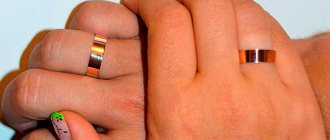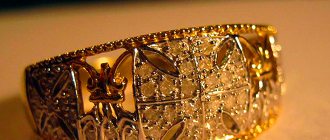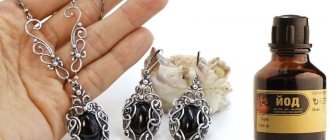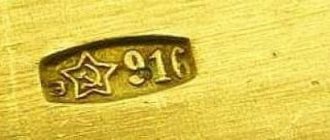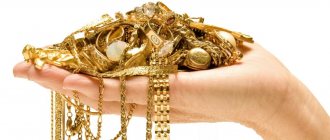Sample systems
The precious metal content here is determined by the number of grams in one kilogram of jewelry alloy.
For example, 1000 g of 750-grade alloy contains 750 grams of noble metal and 250 g of other impurities, or alloy. In the Russian jewelry industry, 375, 585 and 750 samples are most often used to make gold items. This system is common in the USA, Europe, China and other countries. One carat is equal to one twenty-fourth of the weight of the alloy, according to the British carat system. 24 carat (24K) gold is 999.9 pure and free of any impurities. 14 karat gold (14K) contains 14 parts gold and 10 parts other metals. Jewelers use samples of 9, 10, 14, 18 and 24 carats for their products.
The numerical designation of the sample is applied to all jewelry, but not all jewelry is marked according to a single system. Today, two sample systems are used - metric and carat, but in the last century in Russia the spool system was used.
Metric
Used in most countries of the world. The highest standard of the system is 1000th. For example, a 750 gold alloy contains 75% gold, the remaining 25% comes from other metals.
Carat
Currently used in some European countries and the USA. The highest standard of the system is 24. Samples of 9, 14, 18, 22 are used - they show the content of pure precious metal in the composition. For example, 18 karat gold means that 18 of 24 parts are pure gold (this corresponds to 750 fine gold in the metric system). 1 carat in this system is equal to 9.744 grams.
Zolotnikovaya
Spool samples are old gold samples; they are no longer used. This system was used in Russia until 1927. The highest standard is 96. The units of measurement are:
1 pood = 40 pounds = 16.380 kilograms.
- 1 pound = 96 spools = 409.512 grams.
- 1 spool = 4.266 grams = 96 shares.
- 1 share = 0.044 grams.
For marking jewelry, samples of 56, 72, 92, 94 were used. If a sample of 56 was indicated, this meant that 1 pound (96 spools) of such an alloy contained 56 spools of pure gold (this corresponds to 585 samples of the metric system).
- The karate system was presented to the world by the British and is used not only in Western Europe, but also in the USA. According to this system, one carat is equal to one twenty-fourth part of the alloy. Thus, absolutely pure gold is estimated at 24 carats, and an alloy in which a quarter contains another metal is, accordingly, 18 carats gold. The following grades of gold are used in jewelry: 24, 18, 14, 10 and 9 carats.
- The metric system defines a good standard of gold differently - it takes into account how many grams of pure gold are present in a kilogram of gold alloy. Such a system was introduced on the territory of the former USSR in 1927 and is successfully used in the post-Soviet space to this day. In accordance with it, the highest standard (999) is for pure gold, then samples with a lower gold fraction in the alloy are designated in descending order.
So, our ancestors would respectfully call the 999th sample red gold - it was from this almost pure metal that in the old days the royal chervonets were made, soft and very expensive. Worth its weight in gold - this saying also comes from those times. The highest standard of gold is too soft a metal to be used for making jewelry, and therefore it is almost never used by jewelers.
Next, according to the assessment of gold content and, accordingly, cost, are the 958th sample (also a soft and dull alloy, not used by jewelers), 750th and 585th. The last two are the most common and popular today. If you compare: gold purity 750 and 585 - which is better, then the answer will be ambiguous.
Sample 585 contains significantly less gold content (62%), its cost is lower, and its strength characteristics are higher. Gold of this standard is perfect for wedding rings and other jewelry for daily wear, since it does not tarnish for a long time and is resistant to surface deformation (scratches). The color palette contains mainly
375 is considered the most economical, but this alloy has a significant drawback - it quickly fades in air.
What are the types of samples: carat and metric systems
There are four measurement systems in our world, but the most popular are the carat and metric systems.
The carat system dates back to ancient times when people began to measure the value and purity of precious products in carats. Pure metal without impurities has a value of 24 carats. How many grams of pure gold are there in 1 carat?
One carat of metal contains one twenty-fourth of the gold in the bulk of the alloy, which is reflected in the UK carat system, which is also used in the USA and European countries. An alloy of 14 carats is composed of 14 parts of pure gold and 10 parts of another metal, and jewelers in their work usually use compounds with a purity of 24, 14, 18, 10 or 9 carats.
In Russia, as part of the Soviet Union, in 1927, jewelers switched from the carat system to the metric system, in which the share of the precious substance in the alloy was calculated based on the number of grams of pure metal per kilogram of alloy. Thus, an alloy of 500 purity contains 500 grams of pure aurum, and the other half of the mixture contains other metals. Nowadays, the Russian jewelry industry suggests that the gold standard in jewelry can be: 375, 500, 585, 750 and 958.
For some time, Soviet jewelers produced products from 583 markings, which in the Western system were classified as fourteen carats, although foreign standards were slightly higher. After the collapse of the USSR, the 583rd sample was replaced by the 585th and our products became equal to Western ones. Thus, the 585th hallmark is equal to fourteen carats of gold.
The 375 marking represents 38% pure metal. Copper and silver are used as impurities, and the surface of the products is yellow. But over time, iron sulfide appears on the surface of the product, after which it becomes dull.
The 500th sample contains 50% of the precious substance, and the rest is occupied by silver and copper.
The 585 marking is widely used in the Russian jewelry industry. The alloy contains 58.5% gold, and the rest is silver, copper and even palladium. This combination of materials gives the product maximum strength, hardness, and resistance to environmental influences.
However, the most optimal in the jewelry industry is 750 standard with 75% precious metal content in the alloy. Nickel, silver, platinum, copper and palladium are added to it. The compound can have different shades: from bright green to red. Due to its excellent hardness, strength and fairly easy processing, it is widely used in the jewelry industry, but is quite expensive.
The 958th standard is practically not used in jewelry, because the compound contains 95.8% gold. Such a high content of precious metal results in a soft surface of the product and a dull color, as well as a very high price, which, with inexpressive characteristics, makes such a product impractical.
And finally, the highest sample value - 999, represents the precious element in its pure form, virtually without impurities. Nowadays, pure metal is almost never used for the production of products, because pure gold is very soft and easily deformed, and at the same time has the highest cost.
Comparison of multi-colored gold
Fineness is a value indicating the number of parts of gold in an alloy. The physical characteristics, color and cost of the metal depend on the number on the sample. Obviously, determining which gold standard is the most expensive is quite simple. The most valuable is the presence of a large amount of gold in the alloy. This means that the higher the purity value, the higher the cost of the gold alloy.
Pure 999 gold is a metal prone to deformation. To ensure that precious metal products retain their shape, alloys are created. The main components of the alloys are:
- gold as the main component, in the amount of 375, 585 or 750 parts;
- silver;
- copper;
- palladium;
- platinum;
- sometimes nickel;
- rhodium, as a coating on white gold, to give it shine and durability.
Gold of any color can be represented by alloys of 375, 585 and 750 samples.
The most expensive option in each color is 750 sample. The percentage of precious metals in the alloy will help answer the question of what is more expensive - white or yellow gold. Adding platinum to white gold makes the metal more valuable than the yellow alloy containing silver and copper.
What is the difference between white, yellow and red gold?
The main colors of gold jewelry are yellow, white and red. The shade of the alloy is not related to the grade. For example, a ring with the mark 585 can be of any color. The changes concern only the ligature:
| Yellow | Red | White | |
| Gold | 585 | 585 | 585 |
| Silver | 187,5 | 80 | 225 |
| Copper | 227,5 | 335 | |
| Nickel | 165 |
To obtain a white tint, in addition to nickel, platinum and zinc are used.
Different colored alloys of the same grade have the same quality. However, the components of white gold - zinc and nickel - often cause allergic reactions. Jewelry with platinum is harmless and has a higher value than jewelry of other colors.
Which gold is more expensive - white, red or yellow?
What shade of metal should you choose? And is it worth choosing by color? After all, the cost of jewelry is not determined by it, but by the amount of gold content in the alloy. Accordingly, the higher the standard, the greater the percentage of gold.
For example, the red color of gold is very attractive, but copper occupies a much larger part here than the precious metal. The price, compared to other types of gold, is much lower. But this has absolutely no effect on popularity.
And again we come to the conclusion that white gold is the most precious due to the addition of platinum or palladium components. White gold jewelry is a sign of prestige; it signifies belonging to the highest rank.
Sources
- https://zolotoe-runo-sl.ru/dragocennye-kamni/samoe-dorogoe-zoloto.html
- https://golden-inform.ru/proby/zolota-kakaja-luchshe/
- https://zaimzoloto.ru/articles/kakaya-proba-luchshe/
- https://top10a.ru/samoe-dorogoe-zoloto.html
- https://zhazhdazolota.ru/proby/kakaya-luchshe
- https://sunmag.me/sovety/20-11-2014-kakoe-zoloto-samoe-dorogoe.html
- https://VseoMetallah.ru/uvelir-isdelia/kakaya-proba-zolota-luchshe
- https://999proba.com/kakaya-proba-zolota-samaya-luchshaya/
- https://DedPodaril.com/zoloto/imform/pravila-vybora-zolota.html
- https://inzoloto.ru/precious-metalls/kakoe-zoloto-dorozhe-zheltoe-beloe-rozovoe
- https://zolotoe-runo-sl.ru/rekomendacii/kakoe-zoloto-luchshe-krasnoe-ili-zheltoe.html
Individual features of the 585 brand
Before considering 585 gold, you need to understand what is a hallmark? This is finding out the amount of a particular element in a manufactured piece of jewelry. This indicator clearly demonstrates mainly the quality of the product.
585 is considered a high grade for jewelry in the jewelry world. It became popular in 1994 and replaced 583, which was considered the best quality rating only in the Soviet Union. According to GOST, which is valid throughout the world, 585 metal is equal to 14 carats. The share of the main element is 58.5%, the remaining 41.5% belongs to a mixture of silver and copper.
Based on the data presented, it turns out that 585 gold contains several metals, namely gold, silver and copper. This combination of metals gives the jewelry strength, stability of appearance and durability.
In addition to strength and consistency in appearance, 585 gold can have different shades of color, the appearance of which is caused by different variants of alloys of several metals: gold, silver, copper and others, for example:
- red color appears with a mixture of 33.3% copper, 8.2% silver and 58.5% yellow metal.
- pink - a compound of 18.2% silver, 58.5% precious element and 23.3% copper.
- green – a compound of 58.5% precious element, 35.9% silver, 5.6% copper.
- white – a compound of 58.5% base material, 16.0% copper, 17.0% nickel, 8.5% zinc.
In addition to pure colors, there are mixed ones:
- red-yellow;
- yellow-green;
- light yellow.
Each of the above colors gives the jewelry its own density:
- red – 13.2 g/cm2;
- green – 14.3 g/cm2;
- red-yellow - 13.6 g/cm2;
- yellow-green – 13.9 g/cm2;
- light yellow - 13.1 g/cm2;
- white – 12.8 g/cm2;
The presented options for a mixture of metals show that the ingredients to create the necessary proportions of 14k gold often change, but the proportion of pure yellow metal is constant under any circumstances. This fact indicates the high quality of the jewelry.
556 standard is one of the names of 585. It is determined according to certain systems: metric, spool and carat. According to the metric system, the highest quality is defined as: 585 or 583 gold. According to the spool system, it is defined as 556.
Price policy
The price of 585 marks of precious material varies from 2450 to 3200 rubles per 1 gram. However, the price can be either higher or lower, it all depends on the rate determined by the Central Bank, for example, as of March 2021 it amounted to 2267 rubles and 5 kopecks. The cost also depends on the concentration of copper and silver in the jewelry.
However, the presented cost of gold is indicated only in stores and various jewelry stores; pawnshops set a different figure. Due to the fact that the price in salons is for the product, and in pawn shops it is exclusively for the metal itself, therefore, it is often an order of magnitude lower. For example, in Moscow pawnshops the price of jewelry made of 585-carat precious metal is approximately 745 rubles.
Application
Most often, 585 standard precious material is used to make wedding rings, since it is believed that this is the most commonly worn jewelry by people compared to other jewelry - earrings, pendants, chains and bracelets. It is also loved by those who are used to looking rich and elegant.
Despite the fact that rings are the most famous jewelry made of 585 gold, earrings are not far behind them, since their frequent owners are girls who love to wear all sorts of variations of this product.
So, some girls love earrings with stones, and some get by with simple “studs”, but regardless of the shape and decoration of the jewelry, it is made mainly from 585 gold, as they are focused on constant use, and, therefore, the need to give durability to the product.
Modern approach of jewelry factories
The current economy is growing due to variations and modern methods
Thus, you should not pay attention to the sample of a gold product if it fluctuates within the same proportion of pure gold
Today, it no longer matters which gold standard is better than 583 or 585, since current manufacturers have moved away from low-quality products, revealing the whole truth before the eyes of buyers. If you want to get a massive product of the highest quality, pay money
If you need a more economical option, here is a thin product that will not be inferior in quality, but at the same time it will have an affordable price and a beautiful design. Current manufacturers give the buyer the right to decide for himself what he wants to see, how much he expects to pay, and offer him just such a piece of jewelry
If you want to get a massive product of the highest quality, pay money. If you need a more economical option, here is a thin product that will not be inferior in quality, but at the same time it will have an affordable price and a beautiful design. Today's manufacturers give the buyer the right to decide for himself what he wants to see, how much he expects to pay, and offer him just such a piece of jewelry.
The modern market of Ukraine and Russia carefully monitors with its control bodies the quality and grade of the metal from which further jewelry is made. Therefore, you should not worry that today’s gold is somehow inferior to what it was in the Soviet Union. Modern businessmen and entrepreneurs who respect their business will never sell goods of unknown quality, without accompanying documentation and certificates. The fear of receiving a low-quality product, like Turkish gold, must be forgotten forever.
Today, both Ukraine and Russia produce all gold of only 585 standard. This is approved according to GOST and no other options are provided. Each manufacturer has the right to give their metal a special shade or color at the expense of other metal impurities, but regardless of the color of gold, all of it has the highest 585 standard. It is the color of gold that often becomes the cause of many unfounded disputes regarding the sample. Since, in the USSR, all gold had a red tint due to the large amount of copper and nickel in it.
Alloy shades
Products with purity 750 have a rich color palette. And you can get the desired color by adding metals.
There may be several shade variations.
- Yellow. This alloy contains 750 units of aurum, 170 units of argentum (silver), 80 units of cuprum (copper).
- Pink. 750 - aurum, 40 - argentum, 125 - cuprum.
- Red. 750 - aurum, 40 - argentum, 210 - cuprum.
- Green. 750 - aurum, 250 - argentum.
- White. 750 - aurum, 50 - argentum, 200 - palladium.
The most desirable purchase today, according to numerous surveys and sales results, is white gold. It looks the most noble. But there is no arguing about tastes, which is why other variations find their buyers.
How sample 583 was transformed into sample 585
The 583 gold produced in the USSR fell 0.01% short of the 14-karat standard (many countries still use the karat system rather than the metric system) and therefore were not quoted in the West. Traditionally, in the Old World, preference was always given to gold in the following shades:
- white;
- yellow.
And in the USSR, alloys with a reddish tint were more valued. And this Soviet gold was considered vulgar and tasteless in many European countries, and sold poorly. In general, in order to correct this situation, they decided to change the sample slightly - at least this is the official reason.
Although it must be admitted that the technical characteristics of products made from 583 gold were no worse, and sometimes even better. It is not without reason that for many years the described sample 583 had the status of the most reliable and wear-resistant in the Union.
Real gold content in 583 and 585 samples
It must be recognized that there is not always more gold in 585-carat products than in 583-carat products that are similar in all other respects. It would seem that this is contrary to logic, but the nuance is that in gold-silver, gold-copper and gold-copper-silver alloys the remedium (deviation from the standard) is equal to three units. In other words, in 583-carat alloys, the exact gold content can be in the range from 580 to 586 units. And gold alloys, where nickel is present, have an even greater remedium - here it is equal to five.
583 gold
What remedium is for 585 alloys? It is also now set at 5 units, and at the same time it can only be positive. That is, a downward deviation is excluded. In other words, in a product made from 585 gold, the real content of yellow precious metal can reach 590. Of course, here we are talking about legal and certified products, and not about cheap fakes produced from nowhere.
Use in decorations
Jewelry with such a high standard does not appear on the shelves. The fact is that, due to its fragility, and also to ensure that such gold does not deform or break, even the smallest ring must weigh at least 10 grams, which, you see, is not very practical.
Some may remember "White Gold". There is a fairly common misconception that it has a very high standard.
White gold has gained its popularity a long time ago. It is an alloy of pure gold with nickel, manganese and palladium.
White gold bracelet.
Shades can range from light pink to completely white.
Radium can also be added for a completely white tint. It costs significantly more than gold. But at the same time, the gold itself used in white gold jewelry is a maximum of 750.
As a rule, the highest standard of gold used in jewelry is 750. Today, this standard is relevant in European countries. It is flexible enough to make very elegant and delicate jewelry. But at the same time, gold of this standard is practical, durable, retains its original appearance well, can be passed on from generation to generation and remain just as beautiful.
Famous world-famous jewelers make their branded items from gold of this standard.
Often on the price tag of such a product you can find the designation Ni. So, in the ancient stories of German philosophers they called the evil spirit. They tracked down those who were looking for copper and tossed them the mineral, which they mistook for copper ore. When they began to smelt it, it released arsenic gases. That's why they disliked him. It was impossible to obtain ore from this material. For this she was given another name - “Copper Devil”. Then scientists began to study it closely and another metal was obtained - nickel.
Nickel was named Allergen of the Year at the 2008 American Dermatological Society Meeting. Today, in the European Union countries it is excluded as much as possible from any objects that come into contact with the skin.
Palladium - symbol Pd. Belongs to the platinum group. It has a beautiful silvery white color.
It is obtained by processing platinum, nickel, copper, and silver. It is a precious metal and participates in trading on stock exchanges along with gold.
At the same time, palladium is very expensive and one can answer for sure that if any standard can be on an equal footing with it, then only the most expensive standard of gold is 999. Being part of an alloy, it gives gold an exceptional hue.
An enamel pattern is well superimposed on gold of this standard.
Application
When exposed to high heat, 750 gold lends itself well to processing. This alloy can be used to make relief, cast and link jewelry. Jewelry is the main use for gold. But one should not discount the active use of precious metal in industry, optics and many other areas. For example, wires or thin plates of 14k gold can be seen in electronic and measuring instruments.
The alloy can be considered very flexible, therefore the possibility of obtaining special, filigree patterns from this gold is more than high. Yellow gold is the most recognizable in the post-Soviet space.
But the demand for white imminent is growing, especially because it pairs perfectly with diamonds.
Which samples are preferred in different countries?
In Europe, there is a carat system in which one carat corresponds to one twenty-fourth of the gold in the alloy. In the countries of the former USSR, the metric system is used to determine mass when pure gold in an alloy is measured in grams.
Now in Russia and Ukraine, many jewelry connoisseurs prefer 585 standard, much less often 750. In Europe, on the contrary, products with 750 and higher are popular.
In Italy, products of at least 750 standard are quoted. Although these jewelry are certainly beautiful, Italians do not wear them every day, but limit themselves to costume jewelry and decorate themselves only on special occasions.
750 gold standard, accepted in the Russian Federation, differs from the European standard. The ligature of this alloy in Europe contains a larger amount of silver, while ours contains more copper. Therefore, our gold is red in color and more durable, while European gold is more yellow in color.
Any piece of jewelry in the Russian Federation or abroad must have a stamp that contains information about the corresponding hallmark. And in some countries, jewelry also contains information about the manufacturer.
When deciding to purchase jewelry or invest in gold, you must first of all decide what grade of gold is preferable. It is better to buy products by first studying the typical composition of jewelry in the country in which the purchase will be made.
It would be useful to inquire about the composition of the alloy and the amount of impurities in the jewelry, so that in the future it will not only be a beautiful decoration, but also a profitable investment.
It will also be useful to find out which precious metal is better to buy: gold or silver?
Greetings, dear readers
In this article we will look at which standard of gold is better, what to look for if you decide to purchase jewelry or investment metal. There are many official alloys: 333, 375, 417, 500, 585, 625 and others
But no more than three or four varieties are used to create jewelry, which is explained by their characteristics.
Price
Both manufacturers and consumers of jewelry are interested in one of the key issues – the price per gram of gold. 750 gold is one of the most sought after, but also the most expensive.
Its cost is determined by several aspects:
- The price set on the world market.
- Prices for gold set by the Central Bank of the Russian Federation.
- Cost of a jeweler's work.
- Cash costs in industrial production.
The average price for 1 gram is 4,000 rubles.
Soviet stereotypes
Any jewelry has its own remedium, which can vary within three units. This means that 585 gold may contain a different percentage of pure metal. It may fluctuate within these three units and be mistaken for another sample. The more impurities and other metals there are in an alloy, the more vibrations it will experience. For example, gold, where there is nickel, can deviate in remedium by up to 5 units. This technical nuance completely erases the boundaries between 583 and 585 hallmarks, in particular for those who seek to buy gold and gold products only of the highest standard.
Many people are accustomed to considering 583 to be the best test, since queues lined up for it in Soviet times. For many, such a discovery will seem implausible. Since gold jewelry of the Soviet period does not lose its appearance over many years of storage in boxes or when worn. At the same time, Soviet gold is quite durable and does not lend itself to deformation. All these tricks lie on the conscience of the jewelers, who were supposed to give people exactly what they wanted to see. Since wedding rings smaller than 5-6 millimeters were considered cheap and of poor quality, jewelers tried to provide such a product to the people. A large number of impurities were added to gold, and this automatically made gold products strong, hardy and durable.
Today, an ounce of gold costs around $1,700; in Soviet times, the amount per ounce never exceeded $300. It follows from this that the price of today's gold has increased several times, and young people are more willing to buy thin and sophisticated products of the highest standard, which can become deformed over time due to the softness of the metal.
How to care for 750 products
Jewelry 750 is a luxury category. Over time, even with infrequent wear, they change color, scratches, deformations, and chips appear.
Products require regular care, even if they are stored and not worn:
● no contact with aggressive cleaning agents, cosmetics, perfumes;
● do not wear it while playing sports or doing housework;
● periodically polish the surface until shiny;
● protect from mechanical damage;
● store in fabric bags or closed boxes without other products.
Store jewelry indoors without sudden temperature changes. The rules for storing stones are also taken into account.
general information
Gold is a metal that is listed in the periodic table of chemical elements under number 79. In Latin it is called Aurum, abbreviated as Au. Gold owes its name to its color, because in translation it means “yellow”. If we turn to mythological sources, then there is an obvious parallel with Aurora - the goddess of the morning dawn, who every day illuminates the sky with a golden morning strip of light. Gold is soft; the metal itself in its pure form is quite malleable and easily bends and changes shape.
It is not so easy to extract pure gold, because it can be hidden deep in the depths of rocks, or mixed with soil, silt, sand, and other minerals. Gold mining can be done industrially, in the form of mining a gold-bearing vein. In this case, the rock is sifted using special heavy equipment, leaving behind the gold grains and discarding the unnecessary soil. Such equipment can also operate on a platform installed in a large body of water. A more painstaking, but quite relevant method of extraction is working in the mountains and on streams.
Typically, gold is washed out of the rocks and settles at the bottom of the stream. It is not always possible to find a large piece of metal; more often, prospectors are engaged in filtering silt and sand, during which gold grains settle at the bottom of special dishes. This method is possible due to the high density of the material. At the bottom you can also find nuggets - pieces of pure gold. However, the procedure is very labor intensive as the particles are often barely visible to the human eye.
Recommendations for care, cleaning and storage
All jewelry, including gold, becomes dirty during wear, so they need to be cleaned.
Expert opinion
Vsevolod Kozlovsky
6 years in jewelry making. Knows everything about samples and can identify a fake in 12 seconds
Items marked 585 do not require special treatment, but they must be polished at least once a week using chamois or cloth. But in order for gold with a 750 stamp to serve for a long time, it is necessary to take care of it, protect it from moisture, mechanical damage and reagents (hydrochloric acid and aqua regia).
The chlorine contained in disinfectants has a bad effect on the condition of any gold, so it is recommended to remove jewelry before cleaning. The same should be done before going to the pool.
It is better to store jewelry in a case, clean it with special pastes and liquids, and polish it regularly.
History of origin
Stamp number 583 has been used for marking since 1927. During this period, the spool testing system, inherited from Tsarist Russia, was replaced with a metric one. The new standards approved 375, 500, 583, 750, 958, 999 samples of gold. These numbers indicate the number of grams of gold per 1000 g of alloy. The more, the higher the gold content in the product.
583 gold
In the USA, England, Switzerland and a number of other countries, a carat testing system is used. Hallmarks are identified as 9, 12, 14, 18, 22, 23, 24 carats, based on the fact that 24 is pure gold.
Earrings 583 samples
Modern samples
375 alloy contains no more than 38% pure precious metal. The ligature is mainly an alloy of copper and silver. Jewelry of 375 standard is especially durable, but very quickly loses its original shine. Due to the high amount of copper they are prone to tarnishing. In the karat system, this gold is identical to 9 carats. Its cost is the lowest. According to many people, the best standard of gold is 999. For products made from it, the opposite is true - the alloy remains bright and shining for a long time, but often bends and scratches.
https://youtube.com/watch?v=SFAumcroYlg
500 - the alloy contains 50% pure precious metal, which is equal to 12 carats. Jewelers do not like to use it, since the alloy has poor casting ability. The shade of this alloy depends on the content of silver and copper in its composition, which is an additional difficulty in the production of jewelry. Products made from this gold sample fade a little after several years of use. Yellow metal 500 has a low price.
585 sample. The composition of the alloy contains 58 and a half percent of pure precious metal, the rest is made up of alloy metals - nickel and palladium, silver, copper. It is more durable and does not become dull after a while. Gold 585 corresponds to 14 carats. The low cost of 585 gold products makes their purchase accessible to consumers with any wallet, so many rightfully believe that this is the best standard of gold.
The addition of alloy metals makes it possible to obtain different colors of 585 standard: red, white or green. This precious metal is a kind of gold standard in the jewelry industry of Russia and other post-Soviet countries. Previously, this standard was the old, one might say the best gold standard for that period - 583, which was replaced in 1995 by the 585th.
750 - has an alloy of 75% pure gold and other metals - copper, silver, platinum and nickel. It corresponds to 18 carats. The precious metal in these products is moderately strong and has good malleability, which is convenient for jewelry processing.
Due to the high content of pure gold, products are not only prestigious, but also not cheap. The high cost makes jewelry made of 750 standard unaffordable for many consumers of the yellow metal.
958 is a high-quality alloy containing 95.8 parts of pure gold, which corresponds to 23 carats. The hue of 958 gold is almost indistinguishable from the color of pure yellow metal. Jewelry has a very soft structure, so it quickly loses its beautiful appearance and is subject to rapid scratches and chips. The jewelry industry does not often make items using 958 alloy. The cost of such gold is quite high and almost identical to the price of pure metal.
999 is the highest of all, and corresponds to 24 carats in the international carat system. This alloy is never used by jewelers. Sometimes in jewelry, a precious metal of this standard is used in the form of various inserts, which are surrounded by more durable and wear-resistant gold, usually a 585 alloy. The price of 999 is the highest of all that jewelers use.
The most common “golden” colors
If you look closely at any gold jewelry, you can accurately determine its “additional” color.
- White, very fashionable in recent years, is obtained using silver, platinum, palladium and nickel. The “economical” option uses zinc, nickel and copper as alloys.
- The red one uses copper as a base, plus a little silver.
- The purple color is achieved by combining palladium, cobalt and aluminum with a gold base.
- Blue, a rather rare two-component alloy, is achieved by combining gold with “regular” iron.
- Green is an addition of silver and cadmium. If tellurium is added to gold instead, the result will be a delicate light olive color.
- Black color can be obtained by adding nickel and cobalt to the base in a certain proportion.
It is worth saying that “colored” gold is always more a tribute to fashion than an investment. For real investments, as before, people use solar metal of the highest standard in the classic “golden” color.
How to determine?
Today there is a large market for jewelry. There is a great demand for this product, so in addition to high-quality genuine products, there are also fakes. Many consumers are interested in the question of whether it is possible to determine the purity and amount of pure gold in a piece of jewelry independently at home. Of course you can. There are several fairly simple methods.
The first thing you need to pay attention to is the color of the product. Pink color indicates that the alloy contains copper and silver
White tint - that the main part of it is made of silver or palladium. If the item has a characteristic purple tint, it means that aluminum or potassium was added to the alloy used to make the jewelry. But the presence of a greenish tint may be the reason that several metals were used to produce the jewelry.
Use a magnet. An item made of pure gold will not be attracted to a magnet. You can distinguish a fake by using table vinegar and iodine. To do this, you need to apply a small amount of iodine to the product and place it in a container with vinegar. If the place where iodine was applied darkens, then you are dealing with a counterfeit.
Brown bread will also help identify counterfeit. Place the decoration in the fresh crumb. After a few days, when the bread becomes stale, remove the product from it. The presence of traces of oxidation and greenery indicates that the jewelry is made of pure gold.
Take a piece of jewelry and rub it against the surface of the unfired ceramic tile. Pay attention to the nature of the marks that remain on the tile. Gold leaves a streak of yellowish color. If the mark has a characteristic dark color, it is not a precious metal.
You can use regular glass. You just need to slide the product over the glass surface. If the jewelry is made of precious metal, it does not leave any marks on the glass, since gold is much softer.
There is another correct, but unsafe method, which involves the use of acid. To carry out this test, you need to buy a special jewelry testing kit. But you need to remember that acid is a very dangerous chemical element; contact with it can be harmful to health.
All of the above methods for determining the sample can be useful if you have jewelry that is not marked. Yes, such products also exist. For example, if the jewelry is old and was made back when no one knew anything about samples. Or the decoration was made to order.
More reliable information about the sample of gold and its reliability can be obtained by contacting the state inspection inspectorate for testing supervision or a pawnshop. An accurate sample can be determined by a special device - an electrochemical detector, which uses a special reagent. Its sensor is applied to the surface of a gold product, it shows the type of metal, the composition of the alloy, the proportion of each component, and, accordingly, the sample.
One of the methods for determining the hallmark of gold products is presented in the following video.
Features of care
Of course, products with 750 purity can be considered luxury, therefore they deserve high-quality care. The shade of the decoration can change under the influence of carbon dioxide and oxygen.
In order for a gold item to remain attractive longer, you need to follow simple rules.
- Do not let the decoration interact with household chemicals and even cosmetics. Any chemical reagents negatively affect the composition of the alloy, although this may not be immediately visible externally.
- It is better not to wear gold jewelry when going to the gym or playing sports.
- To restore your jewelry to its former shine, you need to regularly polish it with a felt cloth or just a piece of natural wool.
- Regular onion juice works great for gold. They need to rub the decoration thoroughly and not wash off the onion layer for two hours. And only then the product is washed and wiped with a soft cloth.
- If the gold is old, or for other reasons darkening and stains have already formed on it, a soap solution with ammonia will return the jewelry to its former appearance. But you shouldn’t keep gold in it for longer than 15 minutes.
- To remove unnecessary risks, gold should be stored in boxes with soft upholstery. These are good boxes. You should not allow items to come into contact with each other, so it is better to store gold jewelry in different compartments.
- You should also not take water procedures while wearing gold jewelry. We can say that this is unnecessary stress for them.
- For aurum, iodine will be an aggressive medium; it forms stains on the surface of a precious item, which will be very difficult to remove. Therefore, gold should be kept away from iodine.
- You can also use GOI paste to clean jewelry.
Gold darkens - that's a fact. And this is typical even for high-grade metal. This negative point can be associated with the oxidation of the ligature. Both copper and silver interact with moisture, carbon dioxide, and oxygen. That’s why silver turns black, and copper turns green (or also turns black). But 750-carat aurum will not darken as quickly as, for example, 585 gold, because it contains less ligatures. And this also affects the price of the alloy and its demand.
Well, if after wearing a gold ring your fingers turn black, you should contact a jewelry specialist. Most likely this is due to the poor quality of the alloy. True, an allergic reaction cannot be ruled out (and it also happens to precious metals).
The ring can also come into conflict with the hand cream - perhaps the cream formula contains elements that gold does not “like”.
There is no point in guessing by stripes and spots, as was previously the case. They appear on jewelry not because of the evil eye, but as a result of banal chemical reactions. And this happens even with high-grade, expensive gold.
The video below demonstrates 750 gold jewelry.
Mark 500
This sample is currently considered rare in the jewelry world.
There are several reasons for its departure from the market:
- only 50% yellow metal - 50% is given to copper and silver;
- strong dependence on a mixture of ligatures;
- difficult to handle.
All of these characteristics make the 500 sample special and at the same time unsuitable for production purposes. Jewelry made from 500 grade precious material is not durable and quickly corrodes; it also has a red tint due to the predominance of copper in the alloy.
500 standard is very popular in the West. It is used to make inexpensive jewelry. Just like in Russia, in the West they change the proportions of metal compounds to create different shades:
- light yellow – 50% precious metal, 33.3% white metal, 16.7% red metal;
- orange-red – 50% base metal, 42.9% copper, 7.1% white metal
- dark yellow – 50% yellow metal, 16.7% white metal, 33.3% red metal.
It is the 500 standard that has found frequent use in the West, where it is used in the manufacture of money, inexpensive jewelry, and vintage items - cigarette cases, brooches, pendants, cufflinks, pins, and pens. Each of these items is coated with a thin layer of gold to give the effect of wealth and luxury.
It is in the West that this metal is especially highly valued and is considered an elite decoration for ladies and a sign of respectability for men.
It is worth noting that the precious metal of this quality grade is as popular as its counterpart in Russia - 585
Gold purity 500 has a lower cost in contrast to the types already described. Its approximate price category in pawn shops ranges from 600 to 800 rubles. for 1 gram.
In stores it costs slightly higher, starting from 2,500 thousand rubles. However, the price also depends on the rate of the Central Bank and other factors, such as retail trade and places of sale (showrooms of large companies, private owners, pawn shops, auctions, small shops).
Frequent places of sale are auctions or pawn shops, where the price of jewelry drops by 2 times. The decline is due to the fact that, as mentioned above, outside of stores, jewelry dyeing is regarded not as handmade, but as metal to be melted down. Therefore, it does not have the same value as in salons.
The type of gold you choose depends on your preferences.
Modern technologies make it possible to obtain types of gold and alloys of completely different shades, varying the proportions of metals in different ways. It all depends on the wishes of jewelers, designers and customers of products.
We hope that we have been able to clarify in more detail what the differences are between types of gold, for example, how yellow gold differs from red gold, why white gold is more expensive than others, and how gold hallmarks differ.
This information will help you quickly and efficiently decide on the choice of gold, and understand what alloy you would like to create or purchase your jewelry from. You can learn how each of these alloys should be processed, and what are the nuances when making jewelry from different gold alloys, in our “YES, I Can” jewelry school in the “Jewelry Making for Beginners” course. You can find out more about the course on the course page
Gold assay systems
What are the different gold assay systems?
Today, there are two systems used in the world for measuring gold samples - metric and carat. Also, on the precious metals market you can still find old “royal gold”, which has different hallmarks - royal hallmarks of gold. In Tsarist Russia, there was a system for measuring the fineness of gold in spools for many decades. The spool sampling system operated in Russia for more than two centuries.
Gold hallmarks in carats
In world practice, mainly in Europe, jewelers continue to use the karat gold hallmark system. Jewelry “imported gold” is measured in carats (from 8 to 24 carats). The karat system is based on calculating the proportion of pure gold in 24 weight units of the alloy.
The content of pure gold in the alloy of six popular samples: 8 carats - 33.3%; 9 carats – 37.5%; 12 carats – 50%; 14 carats – 58.5%; 18 carats – 75%; 24 carat – 100%.
Metric gold standards
The most common stamp on gold in the USSR was the mark of metric gold hallmark - 583. It was replaced in Russia, Ukraine and other countries of the former Soviet Union by 585 hallmark, which is more consistent with international hallmarking standards. Metric hallmarks, like carat hallmarks, show the percentage of pure gold in a gold item.
Standard metric gold hallmarks: 333, 375, 500, 585, 750, 999.
